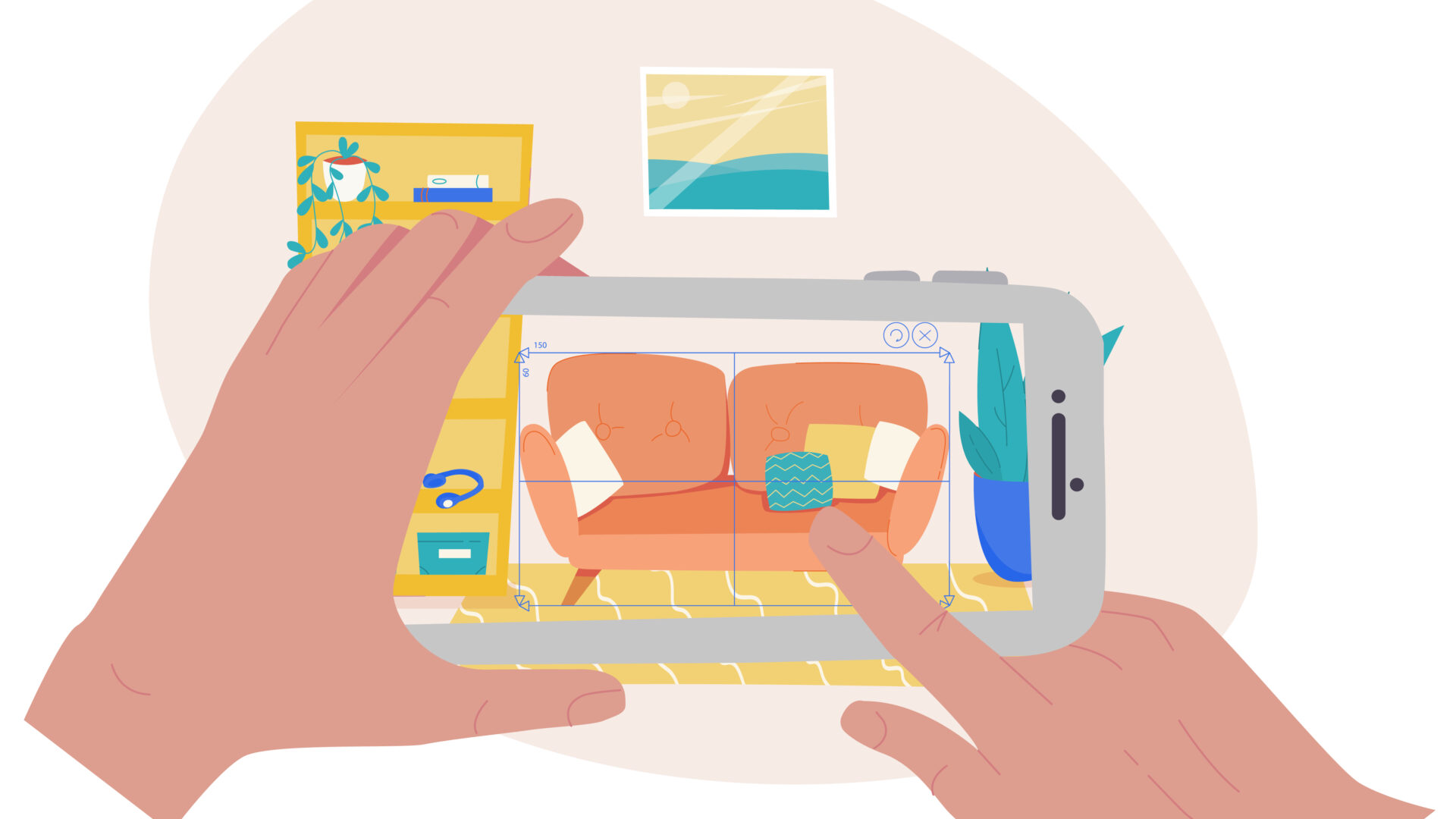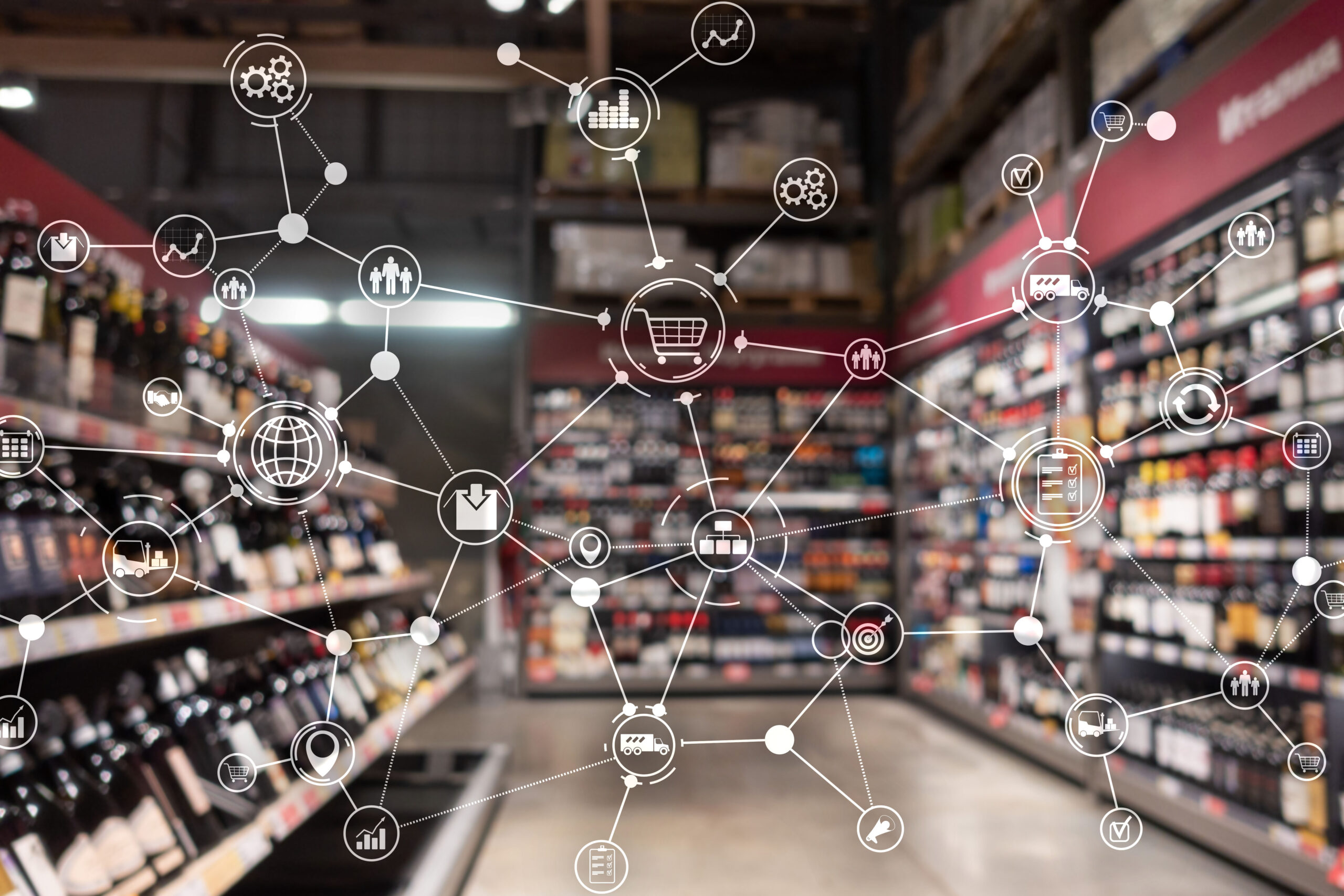If you’re reading this, chances are you’re a forward-thinking business owner or decision-maker in the retail world. Now, imagine offering your customers the ability to visualize how a piece of furniture would seamlessly fit into their home or how a new outfit would look on them, all with just a few taps on their smartphones. This innovative approach to shopping is made possible by using augmented reality (AR).
AR is a technology that blends digital elements with our physical surroundings. It enables users to interact with and experience an enriched version of the real world. By overlaying virtual images, information, or animations onto real-life environments, AR enhances our perception and creates interactive experiences that can be both practical and entertaining.
You may have encountered AR experiences in the real world through popular apps like Snapchat, which uses unique filter overlays, or maybe you also heard about Apple‘s upcoming headset. But the potential of augmented reality in retail sectors goes far beyond mere entertainment. By integrating AR-enabled technology into your retail strategy, you can provide an immersive experience for your customers. It can set your online or physical store apart from the competition.
In this article, we will explore the top 9 benefits of using AR retail tools. We’ll dive deep to understand how this cutting-edge technology can revolutionize how your customers shop.
Augmented reality in retail: The top benefits
Businesses constantly strive to keep up with the ever-evolving retail landscape. We’re here to tell you that adopting AR technology can provide a competitive edge. Incorporating AR into your retail strategy creates an unparalleled mobile app experience that allows customers to interact with your products in a new way.
Let’s take a closer look at the top benefits of augmented reality in retail and how they can elevate your business to new heights.
Enhanced customer experience:
One of the most significant advantages of implementing AR in retail is the ability to offer customers an interactive shopping experience that brings products to life. With AR technology at their fingertips, shoppers can visualize how products would look in their homes, on their bodies, or in their surroundings. This makes the shopping experience more engaging and enjoyable. Ultimately, that should lead to increased customer satisfaction.
A prime example of augmented reality in retail is IKEA‘s Place app. IKEA Place allows customers to use their smartphone camera to see how furniture would look in their homes before purchasing. This innovative approach also helps streamline the decision-making process. Similarly, Amazon introduced the “AR View” feature. It offers customers the same convenience of virtually placing products in their living spaces.
Incorporating AR in retail not only enhances the customer experience but also establishes a strong connection between your brand and its target audience. Businesses can stay ahead of the curve by offering seamless integration of AR-enabled solutions. In other words, they can cater to the ever-changing demands of tech-savvy consumers.
A good customer experience is the cornerstone of any successful retail business. It involves understanding the preferences of shoppers and meeting them. The end result is a positive, memorable, and seamless interaction with your brand. You want the overall shopping experience with your brand to be enjoyable.
Improved product education
Educating customers about your products is crucial for driving sales and building trust in your brand. The online shopping experience heavily relies on it. AR technology offers an innovative solution to showcase product features and benefits in an interactive and engaging manner. By providing detailed information through AR, customers can gain a deeper understanding of your products. This leads to more informed purchase decisions.
One notable example of AR being used to improve product education is the Lego Technic AR app. This app allows customers to bring their set of Lego race cars to life. After building the track, they can use the app to see their cars zoom through on their phones. It gives them a better understanding of the product and increases its value. Lego presents information in a visually appealing format, enticing even more sales.
You might think that some industries don’t necessarily require product education, but that’s not true. Apparel retailers, for example, can provide details on the materials used to make a product or the measurements of an item. Food retailers can provide nutritional information on the ingredients used.
Providing comprehensive product education is essential for gaining and fostering customer trust. It tells them that you know your product, and they can too. AR technology enables businesses to accomplish this by offering a dynamic platform for showcasing product features and usage instructions. Other essential information can also be included. This enriches the customer’s understanding of the product and adds an element of excitement to their shopping journey.
Increased sales
As retailers aim to boost revenue and drive growth, AR technology emerges as a powerful tool for achieving these goals. Offering customers a virtual try-on experience makes shopping more enjoyable. AR can significantly impact purchasing decisions, conversion rates, and overall sales.
The virtual try-on feature has gained popularity on social media platforms. It allows customers to see how products look without physically trying them on. This saves time and effort. It also instills confidence in their choices. Furthermore, AR can assist in presenting personalized product recommendations based on customers’ preferences. It also helps in offering cross-selling and up-selling opportunities.
Take, for example, a furniture retailer that utilizes AR technology to enable customers to place products in their homes. AR provides a realistic preview of how the items would fit and look in their living spaces. Any customer hesitation about style, size, or fit can be put to rest. They will have a greater sense of assurance and be more likely to add the item to their cart.
Another way AR can increase sales is through personalization. Customers can customize their purchases by selecting different colors, sizes, and features. They can also add special messages or graphics to the product for more sentimental value. All these features can then be tried on virtually with the help of AR. Allowing customers to participate in product creation gives them a sense of ownership and delight. Porsche has an excellent example of AR personalization in action.
In summary, AR technology has the potential to drive sales by
- Enhancing the overall shopping experience
- Creating personalized experiences
- Offering customers a real-life glimpse of how products would suit their needs.
Reduced returns
As a business owner, you know that product returns can be a significant concern. Returns can take a toll on your bottom line and even tarnish your brand’s reputation. They happen for a variety of reasons. Maybe customers misunderstood the product description for your item and received something they didn’t expect. Perhaps they weren’t satisfied with the way a particular product fits them.
AR technology can help reduce product returns by giving customers a realistic, 3D preview of an item before they purchase. It gives them a better overarching understanding of your products. That leads to more satisfied customers and a lower rate of returns, creating a win-win situation for both retailers and shoppers.
One remarkable example of AR in action is Warby Parker’s AR app, which allows customers to virtually try on glasses before making a purchase. With this functionality, the likelihood of returns due to incorrect fit or style preferences is significantly reduced. In the beauty industry, Sephora has successfully implemented AR technology as well as “Virtual Artist.” Their makeup try-on feature allows customers to explore different looks and products without needing physical samples. This product type benefits even more users, since they typically have to buy it before they try it.
By incorporating AR functionality into your retail strategy, you can provide customers with a virtual fitting room experience that accurately represents how products will look and feel in real life. It saves time and resources for both your business and your customers.
Drive engagement
In the fast-paced world of retail, keeping customers engaged and connected with your brand is crucial for long-term success. Incorporating AR technology into your retail strategy encourages customers to interact with your products and brand in a new, dynamic way. Ultimately, it fosters stronger connections and loyalty.
Interactive packaging and in-store experiences are just a few examples of how AR can captivate and engage customers. For instance, Adidas launched an AR game where customers could use their smartphones to scan a code on the store’s wall. They would then be sent on a virtual scavenger hunt. Of course, this interactive experience entertained customers. But also encouraged them to explore the store and engage with the brand on a deeper level.
Additionally, AR can be effectively utilized on social media platforms. Use it to drive customer engagement and amplify your brand’s online presence. You can offer unique, shareable AR experiences, generating buzz around your products. It would also create a sense of community among your target audience.
Reduced costs
Cost efficiency is another key factor for any successful retail business. After all, the goal is to make a profit. AR technology offers a strategic solution for reducing expenses without compromising customer experience. By implementing AR, retailers can unlock considerable financial benefits and streamline their operations.
AR serves as a virtual substitute for traditional in-store displays and marketing campaigns. It eliminates the need for costly physical installations. Yet it still provides an engaging and interactive experience for customers.
Furthermore, AR can help reduce product photography expenses. It enables customers to virtually explore a wide range of products without the need to have them physically available in the store. This not only saves valuable space but also allows retailers to allocate resources more effectively.
For instance, think of the space a furniture store could save. AR would offer customers a closer look at each piece of furniture or product variant without setting up a model for each. Adopting AR technology in retail can lead to significant cost savings and operational efficiencies. All while maintaining a high level of customer satisfaction and engagement.
Competitive advantage
Standing out in the retail world is no easy feat. The integration of AR technology can be your secret weapon to capture the attention of new customers and retain loyal ones. Offer a one-of-a-kind, memorable shopping experience through AR. Your business will leave a lasting impression that sets it apart from competitors.
Imagine the excitement and loyalty your brand can generate by providing customers with immersive ways to explore your products. This innovative edge captivates customers and increases the perceived value and convenience of shopping with your business.
With ecommerce platforms like Shopify already integrating AR-enabled features, even smaller retailers can seize the opportunity. Embracing AR in your retail strategy now positions your business as an industry leader. It attracts tech-savvy consumers who appreciate a forward-thinking approach.
And the fact is, very soon, it will be universal. You will actually be left behind if you don’t offer AR to try out your products. Be proactive and join the movement before it’s too late.
Upgrade inventory management
In the realm of retail, inventory management can be a complex and time-consuming task. However, AR technology offers a solution to streamline these processes. You can now ensure product availability and integrate smart resource allocation. With AR in your retail strategy, you can optimize inventory management and reap the benefits of improved efficiency.
Take, for example, Walmart’s AR system. It empowers employees to quickly scan items in the store to check inventory levels and restock them as needed. This real-time information allows for more accurate and efficient merchandising. It also reduces the likelihood of stockouts or overstocking.
Moreover, AR technology can assist in offline inventory management. It provides a visual representation of stock levels and product placement. This makes it easier for staff to identify and address any discrepancies or potential issues.
In essence, incorporating AR into inventory management processes can enhance efficiency and accuracy. You can ensure that your retail business operates smoothly and meets customer demands.
Promote brand loyalty
“Out of sight, out of mind” – is a saying that holds undeniable truth in the retail world. To ensure customers keep your brand at the forefront of their thoughts, crafting memorable experiences is vital. In this regard, AR emerges as a masterful experience architect. It weaves together captivating interactions that resonate with customers and fosters loyalty.
AR-powered apps have the unique ability to draw customers in and keep them engaged with your brand. Consider Nike‘s AR app. It offers customers access to exclusive content and promotions featuring their favorite athletes. This innovative approach not only ignites their interest but also fosters a sense of belonging and loyalty to the brand.
By integrating AR into your retail space, you can create unforgettable user experiences that linger in customers’ minds long after they’ve left your store. These emotional connections pave the way for increased customer loyalty. They also generate positive word-of-mouth, ultimately driving business growth.
Consider these use cases to further illustrate AR’s power in promoting brand loyalty. Imagine a world where customers can virtually attend exclusive events and product launches or even meet their favorite brand ambassadors, all through the lens of an AR/VR app. This level of engagement would undeniably create a lasting bond between your brand and its customers. Incorporating AR into your retail strategy can skyrocket your brand awareness and customer loyalty.
InContext retail execution AR tools
As a business owner, you aim to lead the pack. However, that can be hard to do when you don’t have the right tools in your arsenal. InContext’s Retail Execution AR tool is the innovative launchpad that propels you to the forefront of success.
By harnessing the power of our AR tools, you can bring your in-store displays to life with ShopperMX GO. You’ll benefit from captivating and effective presentations that seize your customers’ attention. We also empower your field reps by reducing compliance barriers and fostering accountability. You can streamline operations while upholding the highest quality standards. Finally, you can tackle complex field communications head-on. Fostering seamless collaboration and efficiency within your team.
As leaders in the industry, we have a proven track record of success. Our immersive AR tools are used by some of the most renowned retail brands worldwide, from Fortune 500 companies to small businesses.
Embrace the cutting-edge capabilities of InContext’s AR tools today. You’ll stay ahead of the curve but also redefine the retail experience for your customers and your team.
Learn more with retail experts today
The retail industry is currently undergoing a renaissance of sorts. Adapting to new realities and emerging technologies is vital to business owners in all sectors. AR emerges as the maestro orchestrating the symphony of change. With VR and AR shopping experiences taking center stage, both brick-and-mortar stores and e-commerce platforms must adapt to survive in this transformed landscape.
The changes to the retail world brought on by the pandemic have only accelerated the demand for augmented reality experiences as shoppers seek safe and engaging ways to explore products. As a business, it is your job to help them make confident purchasing decisions. In this ever-changing retail sector, the integration of AR technology is not just a luxury but a necessity for businesses looking to stay relevant and successful.
Ready to embark on your own journey? Get in touch with InContext to learn more about how our AR and VR solutions can elevate your store to new heights.





